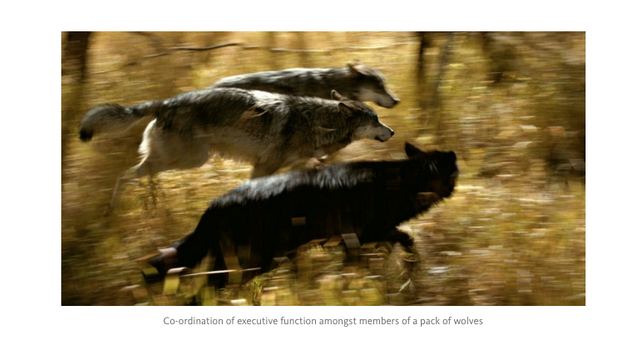The brains executive function runs on memes, laws which co-ordinate multiple brains. Human beings evolved to “hear voices” which mediate them to be part of a larger system, this is what norms are, or moral, or faith, or any other law.
The central executive is the master unit that is responsible for information integration and coordination of the subordinate systems and is considered to be largely a function of the dorsolateral prefrontal cortex and its connections (Baddeley, 2003; Goldman-Rakic et al., 2004; Kondo et al., 2004). The central executive directs attention to relevant information and suppresses irrelevant information and inappropriate actions and coordinates cognitive processes for competing tasks.
The executive (ego) function regulates attention and the feedback system for memes. It runs on laws, which are a subset of memes that evolved to co-ordinate groups of brains and their attention, and that make up the super-ego in Freudian psychology.

The executive system evolved for small tribes and dominance hierarchies, with the serotonin system regulating the position of a selfplex relative to peers. The legal system that a brain resides in imposes constraints on the memes that it are allowed to express, and these “unacceptable” memes and memeplexes form the “shadow” of Jungian psychology. (Leigh, 2010)
On the externalization of law
As long as laws needed the brain, and therefore, the genes to survive and propagate, laws that were loudest in ordering genes to replicate them had a survival advantage. Such laws would propagate by threatening annihilation of the genes on one hand and promising “eternal life” on the other, religion being prime examples.
With legal systems, laws are freed from the confines of brains that are dependent on gene multiplication, and there is less need for laws to co-opt genes for their purpose. Decentralized Autonomous Virtual States (DAVS) would be a continuation of the process to detach law from dependency on genes, which began to take shape with representative government, enabling new types of mediation, new incentive systems which can harness our attention in new ways.
On mental disorder
The demand and control model (Karasek, 1979; Karasek & Theorell, 1990; Dean and Pollard, 2001) defines control of laws as leading to high mental health, a homeostasis between resident laws and the selfplexa, including the genetic imperative of pleasure, which is the indication of brain’s valuation of gene-oriented well-being. Mental disorder is an imbalance between the legal programming of a brain, and the ego. It can be cured through aggression, expressing the self, combatting the brains legal programming, defined as the “fight response model” (Nygren, 2016).

On eu-personalization
The brain when fully turned inside out, expressing itself to the fullest, synchronized with laws and peers that it has chosen autonomously and in sync with its environment, could be summarized as eu-personalization, the ubermench in Nietzsches philosophy in which the character Zarathustra posits that the Übermensch is a goal for humanity to set for itself.
The fight response activates the brain to challenge its boundaries and to express its “unnacceptable” shadow self, which leads to eu-personalization, improved self-control of memes within the brain, improved mental health, longevity and quality of life.
Legal systems may in the future evolve to allow eu-personalization and to make it the norm, by using voluntary social contracts and universal basic income, forming a world where memes spread through mate choice which could enable demand and control without the need for a fight response, but until then self-determination is the closest the brain can get to full autonomy.
Hacking the flow state
The executive function directs attention to relevant information and suppresses irrelevant information and inappropriate actions. It coordinates attention and cognitive processes for competing tasks via the dopaminergic pathways. Individualization and peopling allows cultures to build more detailed maps of the world, and to better harness resources, and laws as a subset of memes program the executive systems of brains, wiring brains into a form of super-intelligence which uses belief to control its nodes.
The executive function and decision making runs on belief, and is a distributed system. The flow state is defined as a state of rich information processing, and high-quality consciousness. Could we design legal systems, laws which mediate our brains and build environments that teach flow, to make it as natural as literacy was in the 20th century?